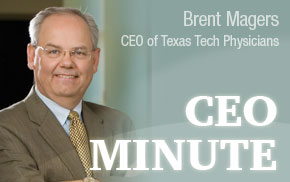
Texas Tech Physicians is joining the national trend of writing electronic prescriptions. Nationwide, more than one-third of the nation’s prescriptions are now electronic, according to the latest count. This is not really a surprise since the federal government has been advocating for years for doctors to e-prescribe. The federal government believes it is safer for patients and there are financial incentives for physicians who e-prescribe. Soon, those who resist will start to see reductions in Medicare payments.
According to reports from the pharmaceutical industry, at the end of 2011, 36 percent of all prescriptions were electronic — the doctor wrote it by computer and sent it directly to the pharmacy with the push of a button. That is up from 22 percent of prescriptions that were paperless a year earlier. For users of the EHR here at Texas Tech Physicians, those numbers are even better. During the first seven months of 2012, we wrote or refilled 51,305 total prescriptions for unscheduled drugs, and 45,561 of those were transmitted electronically, for a total of 88 percent of our eligible prescriptions transmitted electronically. That's 45,561 opportunities for an electronic double check on allergies and drug interactions. It is clinical transformation made real.
For patients, a major advantage is shorter drugstore waits. Pharmacists do not like to decipher handwriting. In addition, computerized ordering systems allow physicians and pharmacists to check for adverse drug interactions. Surescripts has found another benefit — patients tend to pick up a new prescription when it has been filed electronically better than the paper version. The study indicates the reason being that patients are called to remind them to pick up prescriptions. I know my pharmacy does — it is an automated call, but it is effective and it seems I keep getting the calls until I pick up my prescriptions. This is a good example of technology benefiting the patient, physician and pharmacist. It also reminds of us of the importance of calling patients to inform them of appointments. Busy people need to be reminded of important activities — TeleVox is helpful to us in this regard, and many of our departments augment automated call with a personal call from the department. Always a good idea. We are also texting those patients who will allow us to do so.
